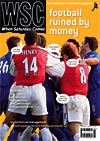It’s back. Or is it? We need to close grounds. We mustn’t have fences again. We can ban people who are caught on CCTV. But the pictures usually aren’t good enough. And bans don’t work anyway. Violence is on the increase. It’s nothing like the Eighties. It never gets in the papers. The media are blowing it out of all proportion.
Some of those statements may be true, perhaps even all of them. But the most noticeable thing about the outcry over the various violent incidents in the past month is that, once again, everyone has very determined views on what to do about them, many of which are completely contradictory.
It would be foolish to argue that hooliganism, pitch invasions and coin-throwing should not be reported or debated. What would be an improvement on the 1970s and 1980s, though, would be if those searching for solutions did not so closely resemble chickens with their heads cut off. In particular, the quest for a “magic bullet” to rid the stands of violence has always been, and will always be, utterly futile. Once upon a time the cure-all was the birch (sometimes in public, on the pitch at half-time). Then came national service, fences (electrified or otherwise), moats, better player behaviour, “short, sharp shocks”, away fan bans, undercover policing, booze bans, compulsory ID cards, all-seater stadiums, and CCTV among others.
To say that none of them worked is not quite fair. The restrictions on alcohol introduced after the mayhem at the 1980 Cup final between Rangers and Celtic were a key turning point in Scotland. Seats and CCTV have, at least, helped move the problem outside the stadiums. But none of the measures introduced, even taken altogether, really did away with hooliganism the first time around (to the extent that it disappeared at all, of course).
No one can tell if the current bout of misbehaviour is the start of something serious or just a six-week wonder – these things are the product of far too many variables to make any safe predictions. In the past, the (mostly conservative) critics who advocated some of the measures listed above were opposed by a small group of (mostly leftwing) dissenters, who, to generalise absurdly, blamed “society” for hooliganism. Their analysis was nearer the mark, but in its own way almost equally useless.
After Heysel, the Observer ran an article comparing the two cities of Liverpool and Turin. One, it decided, was grubby, bolshy and insecure; the other worldly, smart and self-confident. It did not take a genius, the author suggested, to see which one would be more likely to produce football hooligans.
This theme was expanded at the 1990 World Cup, when Italy’s spruced-up stadiums and passionate but wholesome fans were compared unfavourably with their British counterparts. Yet that tournament proved to be one of the turning points in the English game. And ten years on, it was the Italians who had the hooligan problem, whose fans were fenced, caged and rigorously policed, and England who had the glitzy, threat-free world of the Premiership. Or so the story went.
Had English and Italian society changed so much in that decade? Were Liverpool and Turin transformed into their opposites? No. It turned out that “society” was even more complicated than might have been thought. Subtle changes in the way football grounds were organised, and wider social trends, either altered the behaviour of fans or excluded those whose main interest was causing trouble.
One of those changes was the way TV covered the game. And now, perhaps, that is also one of the reasons why violence has made a serious comeback in the newspapers, if not in the stands. The magnifying effect of so many cameras in the grounds ensures that not a coin or a meat pie can be launched in the direction of an unsuspecting player without it (or at least its aftermath) being captured for the world to see.
And with every new incident that is publicised, the likelihood of another similar one occurring increases. In this issue, there are different voices arguing both that the events in Cardiff only got wide exposure because the TV cameras were there, and that Sky’s coverage was keen to play down the trouble. Strangely, both are probably true. While Sky are undoubtedly not keen to bring riots to the Sunday lunch table, the presence of the cameras at such a match is certainly an added incentive for the kind of floating Cardiff fans who appear to have been keen to put on a show.
No doubt all kinds of suggestions will be floated to stamp on the perceived menace of the missile throwers – one newspaper has already seriously pondered the idea of confiscating all coins from fans at the turnstiles. It’s almost equally certain that the trend, if it even is one, will develop in ways that elude any kind of simplistic “get-tough” measure.
From WSC 181 March 2002. What was happening this month
